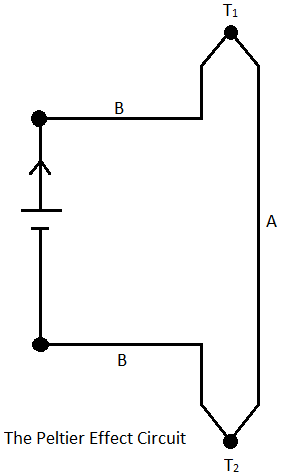
The value of Peltier coefficient of a thermocouple
(A) does not vary with absolute temperature of the junction
(B) varies with absolute temperature of the junction
(C) does not depend on the two different metals forming the junction
(D) varies with the direction of current.
Answer
489k+ views
Hint
In a thermocouple a junction of two dissimilar metals is present. Due to the flow of current heat energy is absorbed or evolved, according to the direction of the current, and its amount depends on the Peltier coefficient. So the Peltier coefficient depends on the junction of the two metals but doesn’t depend on absolute temperature.
Complete step by step answer
A thermocouple is an electrical device which has two dissimilar electrical conductors which are joined together to form an electrical junction. So when

In this given figure, let us consider, there are two metals
So the heat energy absorbed is given by,
where
So from here, we can see that the Peltier coefficient is independent of the direction of current but depends on the two metals that form the junction and it is independent of the absolute temperature.
So the correct answer will be option (A).
Note
The phenomenon of the Peltier effect is normally seen in small commercial thermoelectric refrigerators, as well as in the inverse devices and the thermoelectric generator. Materials having a very large Peltier coefficient have been of much use in designing many systems.
In a thermocouple a junction of two dissimilar metals is present. Due to the flow of current heat energy is absorbed or evolved, according to the direction of the current, and its amount depends on the Peltier coefficient. So the Peltier coefficient depends on the junction of the two metals but doesn’t depend on absolute temperature.
Complete step by step answer
A thermocouple is an electrical device which has two dissimilar electrical conductors which are joined together to form an electrical junction. So when

In this given figure, let us consider, there are two metals
So the heat energy absorbed is given by,
where
So from here, we can see that the Peltier coefficient is independent of the direction of current but depends on the two metals that form the junction and it is independent of the absolute temperature.
So the correct answer will be option (A).
Note
The phenomenon of the Peltier effect is normally seen in small commercial thermoelectric refrigerators, as well as in the inverse devices and the thermoelectric generator. Materials having a very large Peltier coefficient have been of much use in designing many systems.
Recently Updated Pages
Express the following as a fraction and simplify a class 7 maths CBSE

The length and width of a rectangle are in ratio of class 7 maths CBSE

The ratio of the income to the expenditure of a family class 7 maths CBSE

How do you write 025 million in scientific notatio class 7 maths CBSE

How do you convert 295 meters per second to kilometers class 7 maths CBSE

Write the following in Roman numerals 25819 class 7 maths CBSE

Trending doubts
State and prove Bernoullis theorem class 11 physics CBSE

What are Quantum numbers Explain the quantum number class 11 chemistry CBSE

Write the differences between monocot plants and dicot class 11 biology CBSE

1 ton equals to A 100 kg B 1000 kg C 10 kg D 10000 class 11 physics CBSE

State the laws of reflection of light

In northern hemisphere 21st March is called as A Vernal class 11 social science CBSE




